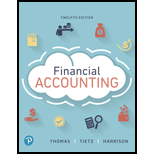
Financial Accounting (12th Edition) (What's New in Accounting)
12th Edition
ISBN: 9780134725987
Author: C. William Thomas, Wendy M. Tietz, Walter T. Harrison Jr.
Publisher: PEARSON
expand_more
expand_more
format_list_bulleted
Textbook Question
Chapter 8, Problem 8.31Q
For the purpose of classifying liabilities as current or noncurrent, the term operating cycle refers to
a. the time period between the date the sale is made and the date the related revenue is collected.
b. the time period between the purchase of merchandise and the conversion of this merchandise back to cash.
c. a period of one year.
d. the average time period between business recessions.
Expert Solution & Answer
Want to see the full answer?
Check out a sample textbook solution
Students have asked these similar questions
hello teacher please solve questions
hi expert please help me
need help this answer
Chapter 8 Solutions
Financial Accounting (12th Edition) (What's New in Accounting)
Ch. 8 - All of the following are reported as current...Ch. 8 - Prob. 2QCCh. 8 - Prob. 3QCCh. 8 - What is accounts payable turnover? a.Purchases on...Ch. 8 - Prob. 5QCCh. 8 - Nicholas Corporation accrues the interest expense...Ch. 8 - Phoebe Corporation signed a six-month note payable...Ch. 8 - Prob. 8QCCh. 8 - Backpack Co. was organized to sell a single...Ch. 8 - Prob. 10QC
Ch. 8 - Potential liabilities that depend on future events...Ch. 8 - A contingent liability should be recorded in the...Ch. 8 - Prob. 8.1ECCh. 8 - Prob. 8.1SCh. 8 - Prob. 8.2SCh. 8 - Prob. 8.3SCh. 8 - Prob. 8.4SCh. 8 - (Learning Objective 3: Account for a short-term...Ch. 8 - Prob. 8.6SCh. 8 - (Learning Objective 4: Report warranties in the...Ch. 8 - (Learning Objective 4: Account for accrued...Ch. 8 - (Learning Objective 5: Interpret a companys...Ch. 8 - Prob. 8.10AECh. 8 - Prob. 8.11AECh. 8 - LO 3 (Learning Objective 3: Purchase inventory,...Ch. 8 - (Learning Objective 3: Record note payable...Ch. 8 - (Learning Objective 3: Account for a short-term...Ch. 8 - Prob. 8.15AECh. 8 - Prob. 8.16AECh. 8 - Prob. 8.17AECh. 8 - Prob. 8.18AECh. 8 - Prob. 8.19AECh. 8 - Prob. 8.20BECh. 8 - Prob. 8.21BECh. 8 - LO 3 (Learning Objective 3: Purchase inventory,...Ch. 8 - Prob. 8.23BECh. 8 - Prob. 8.24BECh. 8 - Prob. 8.25BECh. 8 - Prob. 8.26BECh. 8 - Prob. 8.27BECh. 8 - (Learning Objectives 1, 2, 3, 4: Report current...Ch. 8 - Prob. 8.29BECh. 8 - Prob. 8.30QCh. 8 - For the purpose of classifying liabilities as...Ch. 8 - Prob. 8.32QCh. 8 - Prob. 8.33QCh. 8 - Prob. 8.34QCh. 8 - Prob. 8.35QCh. 8 - Prob. 8.36QCh. 8 - Prob. 8.37QCh. 8 - Prob. 8.38QCh. 8 - Prob. 8.39QCh. 8 - Prob. 8.40QCh. 8 - Prob. 8.41QCh. 8 - Prob. 8.42QCh. 8 - Prob. 8.43QCh. 8 - Group A LO 1, 2, 3, 4 (Learning Objective 1, 2, 3,...Ch. 8 - Prob. 8.45APCh. 8 - LO 1, 2, 3, 4 (Learning Objectives 1, 2, 3, 4:...Ch. 8 - LO 4, 5 (Learning Objectives 4, 5: Account for...Ch. 8 - Group B LO 1, 2, 3, 4 (Learning Objectives 1, 2,...Ch. 8 - Prob. 8.49BPCh. 8 - Prob. 8.50BPCh. 8 - Prob. 8.51BPCh. 8 - Prob. 8.52CEPCh. 8 - Prob. 8.53SCCh. 8 - Prob. 8.54DCCh. 8 - Prob. 8.55DCCh. 8 - Prob. 8.56EICCh. 8 - Prob. 1FFCh. 8 - Prob. 1GP
Knowledge Booster
Learn more about
Need a deep-dive on the concept behind this application? Look no further. Learn more about this topic, accounting and related others by exploring similar questions and additional content below.Similar questions
- For each of the transactions above, indicate the amount of the adjusting entry on the elements of the balance sheet and income statement.Note: Enter negative amounts with a minus sign.arrow_forwardNeed help with this question solution general accountingarrow_forwardDon't use ai given answer accounting questionsarrow_forward
- I want to correct answer general accounting questionarrow_forwardKindly help me with accounting questionsarrow_forwardDuo Corporation is evaluating a project with the following cash flows: Year 0 1 2 3 Cash Flow -$ 30,000 12,200 14,900 16,800 4 5 13,900 -10,400 The company uses an interest rate of 8 percent on all of its projects. a. Calculate the MIRR of the project using the discounting approach. Note: Do not round intermediate calculations and enter your answer as a percent rounded to 2 decimal places, e.g., 32.16. b. Calculate the MIRR of the project using the reinvestment approach. Note: Do not round intermediate calculations and enter your answer as a percent rounded to 2 decimal places, e.g., 32.16. c. Calculate the MIRR of the project using the combination approach. Note: Do not round intermediate calculations and enter your answer as a percent rounded to 2 decimal places, e.g., 32.16. a. Discounting approach MIRR b. Reinvestment approach MIRR c. Combination approach MIRR % % %arrow_forward
- Provide correct answer general accounting questionarrow_forwardNeed help with this question solution general accountingarrow_forwardConsider a four-year project with the following information: Initial fixed asset investment = $555,000; straight-line depreciation to zero over the four-year life; zero salvage value; price = $37; variable costs = $25; fixed costs = $230,000; quantity sold = 79,000 units; tax rate = 24 percent. How sensitive is OCF to changes in quantity sold?arrow_forward
arrow_back_ios
SEE MORE QUESTIONS
arrow_forward_ios
Recommended textbooks for you
 EBK CONTEMPORARY FINANCIAL MANAGEMENTFinanceISBN:9781337514835Author:MOYERPublisher:CENGAGE LEARNING - CONSIGNMENTPrinciples of Accounting Volume 1AccountingISBN:9781947172685Author:OpenStaxPublisher:OpenStax College
EBK CONTEMPORARY FINANCIAL MANAGEMENTFinanceISBN:9781337514835Author:MOYERPublisher:CENGAGE LEARNING - CONSIGNMENTPrinciples of Accounting Volume 1AccountingISBN:9781947172685Author:OpenStaxPublisher:OpenStax College Intermediate Accounting: Reporting And AnalysisAccountingISBN:9781337788281Author:James M. Wahlen, Jefferson P. Jones, Donald PagachPublisher:Cengage Learning
Intermediate Accounting: Reporting And AnalysisAccountingISBN:9781337788281Author:James M. Wahlen, Jefferson P. Jones, Donald PagachPublisher:Cengage Learning

EBK CONTEMPORARY FINANCIAL MANAGEMENT
Finance
ISBN:9781337514835
Author:MOYER
Publisher:CENGAGE LEARNING - CONSIGNMENT

Principles of Accounting Volume 1
Accounting
ISBN:9781947172685
Author:OpenStax
Publisher:OpenStax College

Intermediate Accounting: Reporting And Analysis
Accounting
ISBN:9781337788281
Author:James M. Wahlen, Jefferson P. Jones, Donald Pagach
Publisher:Cengage Learning

Financial ratio analysis; Author: The Finance Storyteller;https://www.youtube.com/watch?v=MTq7HuvoGck;License: Standard Youtube License